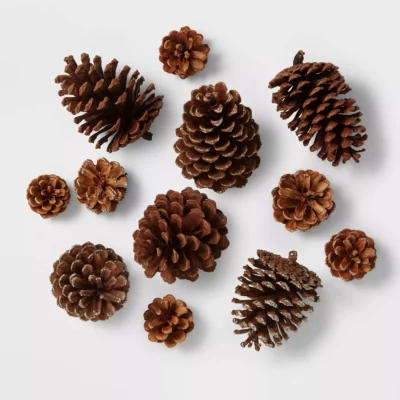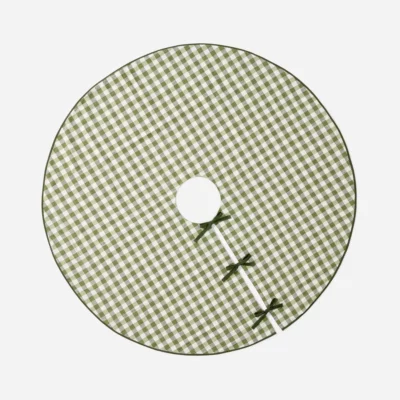We may receive a portion of sales if you purchase a product through a link in this article.
As the holidays approach, I love planning out my holiday decor for the season. While you can’t go wrong with classic red and green, I felt inspired to lean into something fresh: a cozy, earthy theme I’m calling Into the Winter Woods. Layered with deep greens, natural textures, and woodland accents, it’s an aesthetic that celebrates winter’s quiet beauty and brings the outside in. Thanks to Target’s unreal holiday decor collection, achieving this look was simple to pull off. As our partner for today’s post and my go-to for all things festive, I’m excited to dive in and share my favorite picks!
Inspired by Target’s collection, I thought it would be fun to put together a few different themes that celebrate the season’s magic according to your aesthetic. Whether you’re drawn to the nostalgic charm of a vintage-inspired Christmas or the serene simplicity of Nordic Minimalism, Target has everything you need to make it yours. When decorating feels this effortless, you’re free to craft a holiday look that’s perfectly suited to your style—and make this season one to remember.

Into the Winter Woods
This year, I leaned into a warm, natural theme for the holidays. I wanted to create a cozy, inviting feel, where every detail brings the beauty of the forest indoors. I started with Target’s velvet ornaments, each in deep, rich tones, adding a touch of textural charm to the tree. Paired with the green gingham tree skirt, the look balances a rustic feel with soft sophistication. To add visual interest, I layered in a cable-knit stocking and plaid lumbar pillow on my favorite cozy armchair. It’s my favorite place to cozy up.
Throughout the space, I added subtle woodland details, like the glittered deer sculpture and antique-finish ceramic bowl on my bookshelf. Layered with design books and other seasonal touches, the look is impactful while keeping the vibe organic and understated. Target’s mixed green garland and wreath add to the woodland feel, bringing a sense of warmth and comfort to my mantel. In the evenings, I light the blackberry eucalyptus candle and set the mood with tapered candles.
The end result? A holiday space that celebrates the beauty of nature, inviting us to gather and enjoy the season together.
Threshold™ x Studio McGee
Threshold™ x Studio McGee

Threshold™ x Studio McGee
Threshold™ x Studio McGee
Threshold™
Wondershop™


Threshold™ x Studio McGee
Threshold™ x Studio McGee
Wondershop™
Threshold™ x Studio McGee
Threshold™
Threshold™ x Studio McGee
Woven Plaid with Faux Leather Zipper Lumbar Throw Pillow Brown



Threshold™ x Studio McGee
3-Wick Blackberry and Eucalyptus 20oz Glass Jar with Metal Label Candle Green
Threshold™ x Studio McGee

A Very Nostalgic Christmas
This holiday look is all about celebrating the charm of classic holiday decor with retro-inspired pieces that feel like a warm hug. The aesthetic brings together everything that feels wonderfully vintage, from flocked trees with snow-dusted branches to ceramic mini-Christmas trees. Incorporate bottle brush trees to add texture and height to mantels, shelves, or as part of your holiday tablescape. They’ll instantly transport any space to a winter wonderland.
To keep the nostalgic vibe going, use ornaments with retro shapes, colors, and finishes. Weave in strands of tinsel or popcorn garland for extra sparkle. A flocked Christmas tree makes the perfect base for this look, creating that magical, snow-kissed effect we all remember from childhood holiday scenes. (Hello, A Christmas Story.) For smaller accents, arrange charming ceramic houses around your living room. These little touches bring warmth and cheer, inviting everyone to slow down and savor the season. (And yes, we all need a mailbox for our letters to Santa.)
Threshold™ x Studio McGee
Hearth & Hand™ x Magnolia
Wondershop™
Hearth & Hand™ x Magnolia
Wondershop™
Nordic Minimalist
While some holiday homes go bold, the Nordic Minimalist embraces a calm, cozy holiday atmosphere inspired by Scandinavian simplicity. This look highlights neutral tones and subtle accents that add style without feeling cluttered. Ceramic tea light houses bring a soft glow to mantels or windowsills. Minimalist glass ornaments let the tree’s natural beauty shine, creating a serene yet festive vibe.
Drape a chunky knit throw over the sofa for the ultimate cozy corner. A simple pine needle wreath looks stunning above the fireplace, embracing the Nordic love for understated decor. To finish the look, add faux fur stockings for warmth and elegance, and place ceramic animal figurines on side tables or bookshelves. These natural touches create a holiday space that feels modern, timeless, and perfectly hygge-inspired for the season.
Threshold™ x Studio McGee
Threshold™
Wondershop™
Hearth & Hand™ x Magnolia
Hearth & Hand™ x Magnolia
Hearth & Hand™ x Magnolia
26″ Faux Needle Pine & Snowberry Christmas Wreath with Bell Ornaments
Wondershop™
Threshold™
Threshold™ x Studio McGee
You can shop the entire look on my Target storefront, where you’ll find all of my favorite Target buys for every space.
This blog post is sponsored by Target and contains affiliate links. If you purchase through these links, we may earn a small commission at no additional cost to you. Your support helps us continue providing helpful content.












































